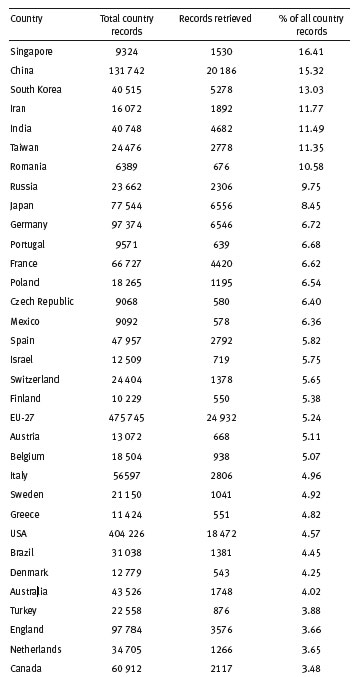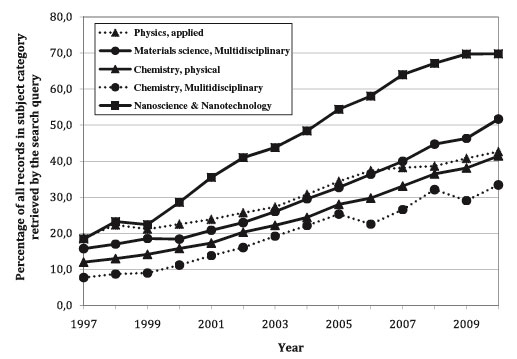| Posted: Aug 23, 2011 | |
Nanotechnology's rapidly growing footprint on the scientific landscape |
|
| (Nanowerk Spotlight) It is quite difficult – not least because there is no consensus about a proper definition – to assess the scope of nanotechnology research and its impact on the overall scientific body as well as its commercialization prospects. In a new attempt to put some numbers behind the general perception of a rapidly expanding nanotechnology field, two researchers at UC Davis have trawled scientific databases and come up with some surprising findings. | |
| What exactly is nanotechnology? One of the problems facing nanotechnology is the confusion about its definition. Most definitions revolve around the study and control of phenomena and materials at length scales below 100 nm and quite often they make a comparison with a human hair, which is about 80,000 nm wide. Some definitions include a reference to molecular systems and devices and nanotechnology 'purists' argue that any definition of nanotechnology needs to include a reference to "functional systems". Back in 2006, the inaugural issue of Nature Nanotechnology asked 13 researchers from different areas what nanotechnology means to them and the responses, from enthusiastic to sceptical, reflect a variety of perspectives. Today, the picture appears to be as diverse and confusing. | |
| Minghua Zhang, a professor in Civil and Environmental Engineering at UC Davis, and Michael L. Grieneisen, a researcher in Zhang's AGIS Lab, have attempted to assess the true scope of nanoscale studies today, by developing a set of search queries based on the percentage of records retrieved by individual terms, which are in the key journals. They reported their findings in the August 19, 2011 online issue of Small ("Nanoscience and Nanotechnology: Evolving Definitions and Growing Footprint on the Scientific Landscape"). | |
| The two scientists modified the original "Georgia Tech" query ("Refining search terms for nanotechnology"), that was developed in 2008, based on the percentage of records retrieved for individual terms that are in the key journals. They expanded the lists of journal titles and carbon nanostructure terms (e.g. graphene, fullerene, bucky-) and added a list of relevant terms which contain the letter sequence "-nano-" internally. At the same time, they added to the exclusion list several nano-prefixed terms unrelated to the field, such as nanosatellite, and some terms which past authors treated as "conditionally relevant" – nanomol*, nanoliter/nanolitre, nanosecond* and nanofilt*. | |
| Applying their search query to the Web of Science database (WoS), Zhang and Grieneisen retrieved records for the period from 1991 to 2010 (they ran their search at the end of 2010). | |
| According to the results, the top 5 countries by number of records were China (20,186), USA (18,472), Japan (6,556), Germany (6,546), and South Korea (5,278). This means that China has now overtaken the USA in annual research paper output. | |
 |
|
| Geographic distribution of authorship for all countries with > 500 records retrieved from Web of Science for publication year 2010. (Reprinted with permission from Wiley-VCH Verlag) | |
| The two authors write that "the percentage of all 2010 WoS records for individual countries which were retrieved by the query was stunning for several Asian countries: Singapore (16.26%), China (15.21%), South Korea (13.33%), India (11.44%), and Taiwan (11.31%), in addition to Iran (11.74%). This indicates a very high priority of nanoscale studies in the minds of the scientific decision makers in those countries." | |
| Pointing out a fact that underscores the massive resources being devoted to nanoscale studies in China today, they note that China's 20,186 nanoscience and nanotechnology records for 2010 outnumbered the 2010 WoS records for China in the broad subjects of materials science (15,231), engineering (17,155), or physics (19,681), but not chemistry (26,663). | |
| It is also interesting that the proportion of "nano"-related articles relative to the total size of the subject categories (such as physics, materials sciences or chemistry) has risen dramatically over the past 13 years: "Materials science, multidisciplinary" (17 to 52%), "Physics, applied" (19 to 42%), "Chemistry, physical" (11 to 41%), and "Chemistry, multidisciplinary" (8 to 32%). See chart below: | |
 |
|
| Percentage of all records in 5 top Web of Science subject categories which were retrieved by the search query. These subject categories had the highest number of records retrieved by the search query for PY 2009. Because these are percentages, data for the partial year of 2010 are included. The footprint of nanoscience and nanotechnology within these fields has grown dramatically in just the past 13 years. Note that the the "Nanoscience & nanotechnology" WoS subject category includes several journals with "nano- to micro-scale" scopes of coverage, thus the query is not expected to retrieve 100% of the records assigned to this category. (Reprinted with permission from Wiley-VCH Verlag) | |
| Zhang's and Grieneisen's conclusion is that, while the 1-100 nm criterion is convenient, it is too simplistic to reflect either the scientific reality of size-dependent characteristics among all materials or the general usage of these terms. | |
 By
Michael
Berger
– Michael is author of three books by the Royal Society of Chemistry:
Nano-Society: Pushing the Boundaries of Technology,
Nanotechnology: The Future is Tiny, and
Nanoengineering: The Skills and Tools Making Technology Invisible
Copyright ©
Nanowerk LLC
By
Michael
Berger
– Michael is author of three books by the Royal Society of Chemistry:
Nano-Society: Pushing the Boundaries of Technology,
Nanotechnology: The Future is Tiny, and
Nanoengineering: The Skills and Tools Making Technology Invisible
Copyright ©
Nanowerk LLC
|
|
|
Become a Spotlight guest author! Join our large and growing group of guest contributors. Have you just published a scientific paper or have other exciting developments to share with the nanotechnology community? Here is how to publish on nanowerk.com. |
|
